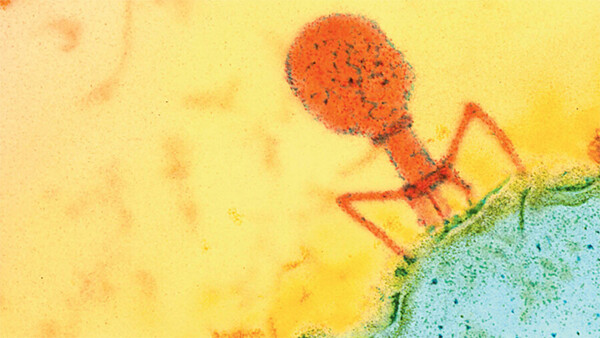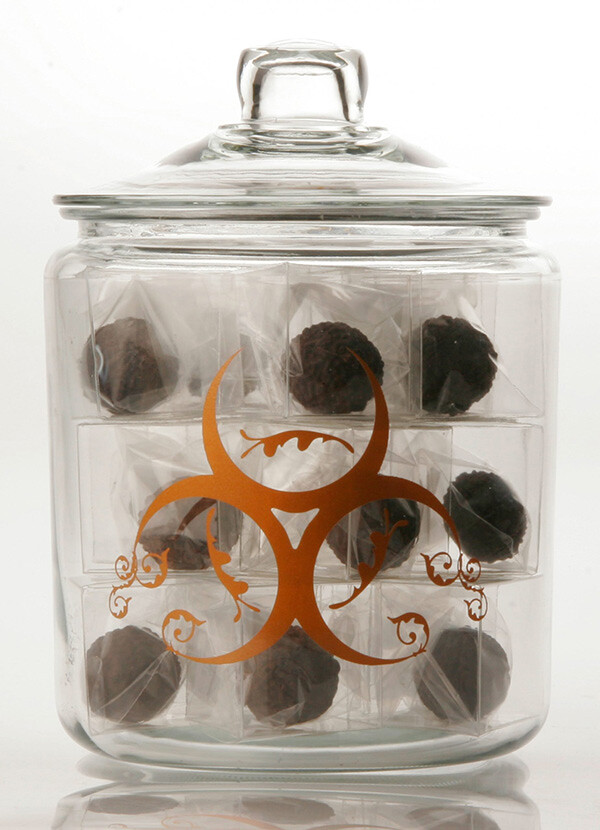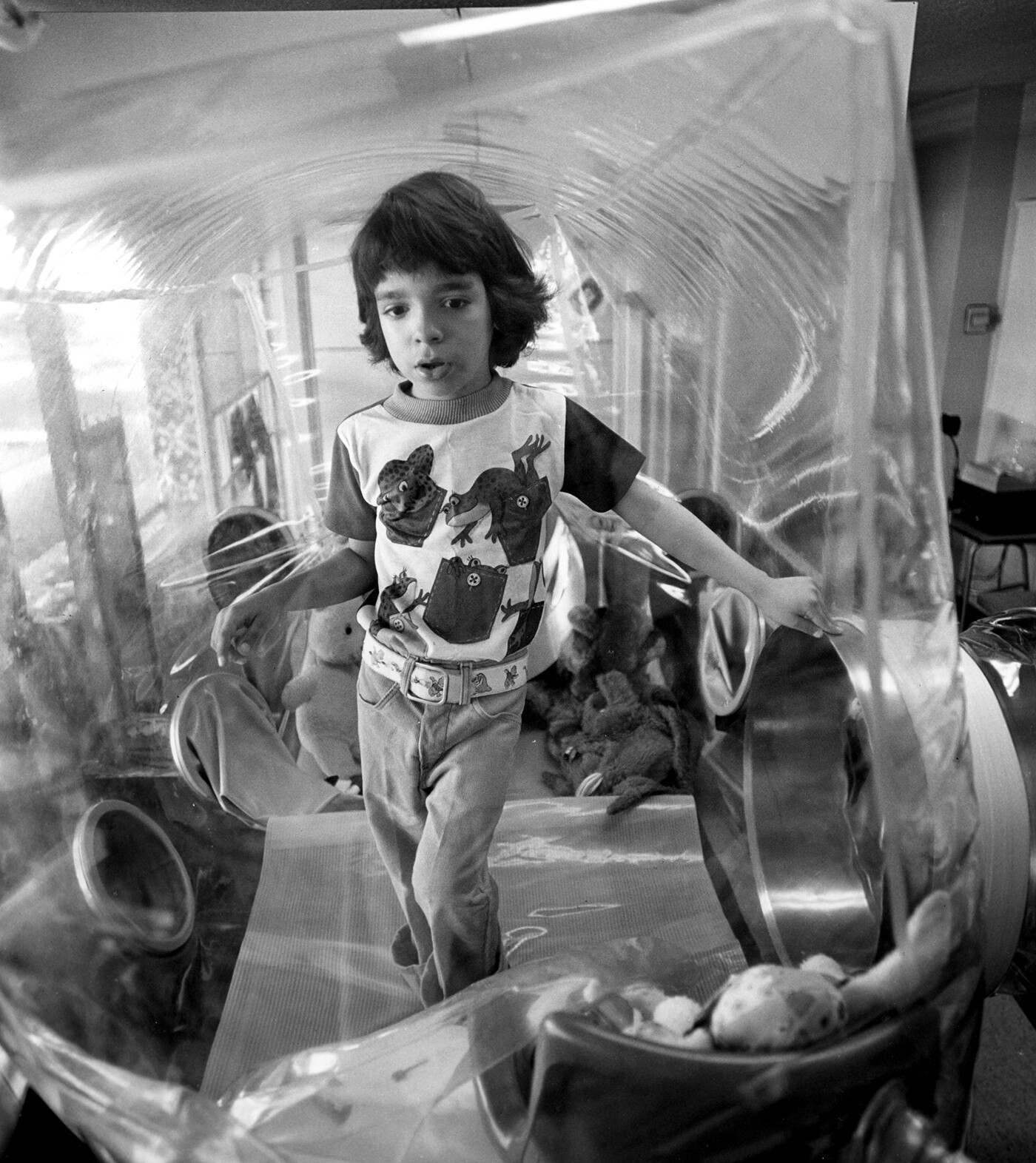Perhaps you thought you could isolate yourself from viruses during the lockdowns of the coronavirus pandemic. Confined to your own apartment or small social bubble, you might have thought you were beyond the sphere of viral influence. Think again. You have always lived within the virosphere—the vast but poorly understood universe of viruses. With every breath, you inhale around six liters of air with thousands (or even millions) of viral particles. Viruses enter your body each time you take a bite of food or a drink of water. Of the billion or so viral particles you encounter each day, you bump into some that are capable of infecting human cells. Other viruses that enter your body belong to the insects, fungi, animals, and bacteria living within us, or near us. These infectious agents are world-forming as well as world-destroying. They are nomadic—constantly floating among cells, bodies, and populations, jumping species and moving between domains of life.
Viruses have been found in seemingly inhospitable locations like deep-sea vents, glacial ice, as well as extremely hot and acidic springs. Genetic diversity on planet earth is a story of viral diversity. Viruses are the most abundant life-form in the world and more than 99.9 percent of viral species remain unstudied. Simply put, viruses are winners in the game of life.1
Viruses have lurked on the margins of cultural theory ever since Deleuze and Guattari suggested that “our viruses make us form a rhizome with other creatures.”2 According to Patricia Clough and Jasbir Puar, in the age of the internet, virality became “a form of communication and transmission across various domains: the biological, the cultural, the financial, the political, the linguistic, the technical, and computational.”3 In recent years, however, viral theory in the humanities and social sciences hasn’t kept pace with the scientific initiatives starting to peek into the virosphere’s vast unknown realms. This special issue of e-flux journal seeks to reckon with the multitude of invisible viral agents waiting to disrupt, detour, and reroute established modes of life.


Bacterophages (phages) are viruses that infect bacteria. New phage therapies are being used to transform the bacterial communities in the human gut. Image: UC San Diego.
Our knowledge of the virosphere is very limited, made from a fragile architecture of “factishes”—provisional facts about viruses that often suffer from the misplaced concreteness of fetish objects.4 Though viruses are commonly visualized with a constellation of scientific apparatuses and analytic techniques, an imaginative leap is always required to “see” traces of any particular virus, as Celia Lowe points out in her essay in this issue, “The Viral Real.” Virologists construct our fragile and provisional knowledge of the virosphere by making informed guesses aided by scanning electron microscopes, X-ray crystallographs, protein models, gene-sequencing machines, bioinformatics algorithms, PCR tests, and rapid antigen detection kits. Interpreting raw data from such a constellation of devices, virologists conjure ontological entities from invisible worlds. In her essay “Contingent Contagion,” Sria Chatterjee reminds us that seeing with scientific apparatuses is a political act that can get in the way of other approaches to reckoning with unseen entities at the edge of the known world.
Against the backdrop of the vast unknown virosphere, a small number of viruses have been studied for their world-forming capacity. Viruses that infect bacteria and other microorganisms are called “phages.” Phages have been widely used in molecular biology labs to introduce new synthetic genes into bacteria. Enterprising biotechnologists have used phages to create all manner of chimera—creatures with genetic components from multiple species. Transgenic microbes—the products of viral, human, and technological intra-actions—are now an invisible part of the industrial supply chain. Phages are involved in the production of a wide range of high-value biochemical compounds, from omega-3 fatty acids to antibiotics, and even specialized perfumes.
Phage viruses also help build worlds in the coral reefs and plankton ecosystems of the ocean. As marine microorganisms dynamically interact with one another and broader ecological communities, they use phages to trade beneficial genes. Some phages help their hosts enhance photosynthesis, while other phages give their hosts new tricks as they hunt for phosphorous, a key nutrient scarce in many oceans. Marine viruses also promote overall diversity in these ecosystems. Members of the plankton community that grow too abundant tend to be culled by viral infections in a diversity-enhancing process ecologists call “kill the winner.” While some neo-Darwinian thinkers like Richard Dawkins celebrate the “fitness” of creatures like birds and mammals, viruses can quickly flip the script of evolutionary success.
Marine microbes, like cyanobacteria, play a major role in the global carbon cycle, pulling greenhouse gasses out of the atmosphere and releasing oxygen. Since viruses control the population dynamics of cyanobacteria, they are tremendously important to life on earth. One article suggests: “We live in a microbial-driven world that only exists because Bacteria and Archaea tempered the previously hostile environment on early Earth.”5 Some marine viruses kill small creatures at the surface of the ocean, which then fall through the water column like snow, sequestering carbon under layers of sediment at the bottom of the ocean. Other phages release carbon at the ocean’s surface, when they make their hosts explode through a process called lysis.6 Another article about the role of viruses in the global carbon cycle suggests that phages run the world.7
The virosphere is an integral part of the planetary biosphere. Viruses are involved in relations of parasitism and symbiosis with every known form of life on earth. They are constantly infecting, disrupting, detouring, and augmenting established modes of life. Viruses operate in many spheres. While mediating geochemical processes in the hydrosphere of the ocean, and floating about in the atmosphere, viruses are also integral to the rhizosphere, where plant roots, mycorrhizal fungi, sand, silt, clay, and water come together in lively assemblages.
Spheres are central to the thinking of Peter Sloterdijk, the contemporary German philosopher who styles himself as the “second coming” of Martin Heidegger. But Sloterdijk has made some odd claims about spheres that are out of step with the latest science about virology and the conditions of life on earth. He insists that humans alone can create bubbles and worlds, while animals—not to mention plants, fungi, or microbes—are trapped in bounded environmental worlds (umwelten) with limited perception and action. Humans alone, Sloterdijk suggests, can transcend the umwelt to become nomadic among spheres, creating and destroying worlds. In some ways, these ideas are nothing new. Martin Heidegger is famous for pushing a similar argument with a three-part thesis: “the stone (material object) is worldless; the animal is poor in world; man is world-forming.”8 Sloterdijk suggests, with his peculiar language, that animals “move around in an ontological cage,” while humans are “ontological amphibians.”9
Viral ontologies, on the other hand, put the limited amphibiousness of the human to shame. Viruses refuse to sit still as stable individuals, variants, strains, or species. They proliferate in mutant swarms—clouds of particles with a fluid genetic makeup.10
Some philosophers of biology question the basic status of viruses, wondering if they are truly forms of “life” or actually “nonliving” things. Sidestepping debates about life and nonlife, John Dupré and Stephan Guttinger have suggested that viruses “should be seen as processes rather than things, or substances.”11 On a molecular level, viruses are “living processes” that interact with other living systems and processes with “interconnected and collaborating segments of many genetically distinct lineages.”12 In his latest contribution to this conversation, Stephan Guttinger’s essay “Viral Things: Twelve Keywords” uses insights from thing theory to reframe fundamental questions in viral theory. Guttinger shifts the conversation away from concerns about virulence and towards ideas related to cooperation, intra-action, and hope.


Lock picks
Inside host cells, viral proteins become lively, deterritorializing and reterritorializing as they intersect with and interrupt distributed cellular processes. In Hannah Landecker’s “Viruses Are More Like Cone Snails Than Hijackers,” she describes how viruses mimic the molecules of their hosts. Within the cell they intra-act with host enzymes and organelles. Viral proteins often bind with the ribosome, an important organelle where viral genes are turned into proteins. In the Golgi apparatus—an organelle that looks like a bundle of deflated balloons—proteins are modified and turned into new viral particles. Viral agency is relational: lively processes work on multiple scales. As viruses interrupt, augment, and reroute processes within host cells, they also influence larger-scale processes in organisms that can take place over generations, or even millennia.
Viral effects on hosts are relational too. In the 1960s, Theodore Rosebury, an expert on biological warfare and venereal disease, coined the term “amphibiosis” to characterize microbes with ambivalent properties. Amphibiosis describes entities that can become “good” or “bad” depending on the situation. But like Sloterdijk’s ontological amphibian, this idea rests on a problematic assumption that dualisms structure relations among entities and worlds. The French anthropologist Charlotte Brives has recently introduced a new idea—pluribiosis—to grapple with the dynamic relationships that transform viruses and other organisms. “Pluribiosis is the recognition of the existence of multiple relational spectra between entities forever in the process of becoming, constantly shaped and transformed by their interactions with other living things, and by the context in which they occur.”13 Pluribiosis is an important keyword in viral theory: viruses are not just good or bad, but pluripotent.
Traditionally, the discipline of virology has focused on identifying and isolating the “bad” infectious agents, with anxiety about disease and death animating most research. More recently, a relatively small group of virologists with symbiotic sensibilities started to characterize potentially good or pluripotent infectious agents.
Cultural theorists have also been preoccupied with bad viruses until recently. Some have equated viruses with “terrorists.”14 But terrorism is just one mode of viral politics. The looming specter of death can obscure an understanding of alteration, a “chronic settling in” that places new conditions on life, as we find in Mel Y. Chen’s essay in this issue, “Death to Death / Life by Cuts.” Lysis, the strategy of immediate viral replication followed by destruction of the host’s cells, involves “the single-minded pursuit of maximum short-term gain,” in the words of Merry Youle, author of Thinking Like a Phage. Many viruses pursue a different strategy known as lysogenesis, where they reside quietly inside the host cell and pursue long-term symbiotic possibilities. It is important to remember that viruses are obligate parasites—they depend on bacteria, plants, animals, and people for their own existence. A parasitic guest that goes to war with its host quickly finds itself without a place to rest and must move on.15
The idea that viruses might “think” is certainly controversial. Few have seriously considered the possibility that viruses have an umwelt, that they are capable of perceiving cues from the environment or acting on sensory information. Arguably, viruses do have the formal properties of a “mental system” as defined by Gregory Bateson. While Bateson never wrote about viruses himself, his 1979 essay on “Criteria of Mental Processes” outlined two key features of mental systems: “1) A mind is an aggregate of interacting parts or components. 2) The interaction between parts of mind is triggered by difference.” Viruses certainly are aggregates of interacting parts that become lively inside the environment of a host cell. According to Bateson, “differences that make differences” induce transformations. Like other mental systems, viruses “become effective differences (i.e., items of information) in the mental process of larger entities.”16
Merry Youle’s remarkable literary compendium Thinking Like a Phage is full of figuration, imaginative metaphors, and empathy. It is a must-read for anyone who is seriously interested in viral theory. The author suggests: “Outside our normal vision, the phage multitude is always there—an ancient, dynamic, bubbling, creative force that underpins all life on earth.” She pushes past the mechano-morphism that dominates mainstream biology to engage in well-informed speculative anthropomorphism about the “intelligent” strategies that enable phages to rapidly transform worlds around them.17
Like any metaphor, ideas about viruses thinking break down when pushed too far. Viruses certainly cannot do much thinking, or even much doing, independent of the living environment of their host cells. But perhaps all thinking—even for human subjects—is done in relation to other beings and things in shared worlds. Following Lacan, Claire Bishop suggests that all subjects are decentered, with subjectivity and agency only emerging in relation to other incomplete entities. The thinking subject, by this analysis, is never entirely decentered (which would result in psychosis) nor entirely unified.18 Viruses are thus certainly good to think with for anyone who aims to understand how decentered human subjects are transformed through interactions with lively agents in shared multispecies worlds.
In addition to seriously considering the possibility of viral thinking, Youle invites us to imagine how phage viruses dance as they move through three-dimensional space. Conventionally, phages are drawn to look like spiders, with spindly tail fibers (like spider legs), a long tail sheath, and a capsid head (like a bulging spider abdomen). The Matrix movie series features phage-like “Sentinels,” which patrol the sewers and passageways of dead human cities. In the words of Trinity, a sentinel is a “killing machine designed for one thing: search and destroy.” Once a sentinel finds a person or human ship, they wrap their tail fibers around their prey in a lethal embrace. While violent imagery continues to dominate the depiction of viruses in popular culture and scientific literature, Merry Youle describes the movements of phages in more careful and delicate terms:
The iconic image of a phage seen on T-shirts and coffee mugs is that of a virion tumbling through the milieu, its six “claws” outstretched, poised for a deadly encounter with a hapless bacteria. However, such images can be misleading. Consider a more restrained possibility: a phage holding most of its tail fibers close to its tail or head, gingerly extending just one at a time to test the waters.
The extension of individual phage tail fibers, one at a time, enables them to feel around for bacterial prey. When a phage comes into contact with a potential host, it walks along the cell surface like a six-legged dancer lightly balancing on one leg at a time. If it finds an appropriate receptor, it binds with the host cell and injects genetic material inside. Some phages take over bacteria to reproduce quickly at their host’s expense, to explode in lysis. Many other viruses—perhaps the majority—adopt longer-term symbiotic strategies and integrate their genetic material into the host’s chromosome.
Some symbiotic viruses contribute to the formation of new microworlds by giving their bacterial hosts an ability to form new external protective layers of biofilm. Others—like the marine viruses that help hosts sequester phosphorous, or enhance photosynthetic capacities—act together with other life-forms on a massive scale, helping to sustain planetary ecologies.
James Lovelock, an influential popularizer of symbiotic theory, has suggested that we scale up our thinking from these dynamic interactions among microbes to consider symbiotic relations on a planetary scale. Lovelock suggests that we conceptualize the earth as Gaia, “an entity comprising a whole planet and having the powerful capacity to regulate its climate and chemical composition.”19 His evidence for the existence of Gaia came from thermodynamics—relating to heat, radiation, and the circulation of greenhouse gasses on a planetary scale—as well as from cybernetics, the field of self-regulating systems that maintain homeostasis. Lovelock’s Gaia appears as a benevolent mother whose health, well-being, and regulatory processes need protecting.
Isabelle Stengers suggests that we move away from the image of Gaia as a caring mother who needs protection, and instead think of her as “the fearsome one,” as she was once addressed by Greek peasants. This rendering of Gaia tolerates humanity, but with limited patience. If we anthropomorphize the earth as a mother, she might be understood as irritable—an entity who should not be offended. If she is disturbed, in the words of Stengers, “the response that Gaia risks giving might well be without any measure in relation to what we have done, a bit like a shrugging of the shoulder provoked when one is briefly touched by a midge.”20
One could interpret the emergence of the coronavirus pandemic in terms of Gaia’s self-regulatory “kill the winner” processes kicking in. Many fear the virosphere, since the unruly realm of viral biodiversity could generate a new pandemic at any moment. But personifying this viral complexity as Gaia assumes a unified whole, a coherent meta-system that governs other systems. Perhaps we should fear, or at least deeply respect, the virosphere in all of it’s vast complexity. Dynamic interactions among viruses and marine microorganisms could suddenly shift, perturbing the conditions that sustain human life on earth. Instead of self-regulating feedback loops, a runaway system could arise in which anthropogenic, virogenic, planktonic, geochemical, and thermodynamic forces reverberate with one another and accelerate.
There are certainly very real reasons to fear, and respect, the vast unknown realms of the virosphere. But an atmosphere of viral anxiety also clouds our understanding of symbiotic arrangements our bodies have already made with a riotous diversity of viral species. The totality of viruses that live within us is known as the human virome. Like the virosphere, our knowledge of the virome is a fragile architecture of factishes. Research on the symbiotic viruses living within us has just begun.
Phages abound in the human body. Internal organs and bodily fluids that were previously thought to be sterile—including the liver, kidney, blood, lymph, cerebrospinal fluid, and brain—teem with viruses. Since these viruses are not associated with serious diseases, nobody noticed them until next-generation gene-sequencing technologies were used to study the human virome. Little research has been conducted on the role that phages play in our central nervous system and brain. Some studies suggest that viruses might help our bodies identify and destroy cancers and tumor cells, as well as plaque structures associated with Alzheimer’s and Parkinson’s diseases. Since many fungi, bacteria, and animal viruses can produce changes to neurons and observable behavior, some scientists have started to speculate about the possibilities of phage “mind control.”21 Thinking like a virus could soon take on radical new meanings.
Around ten trillion bacteria and two trillion phages live in the microbiome of our gut—by far the most complex, dense, and dynamic part of our microbiome. Our gut is coated with mucus just like the phlegm in our respiratory tract. Mucus is a sticky trap for microbes. On a molecular level, mucus is made up of mucins, a molecule with an idiosyncratic structure—a distinct molecular signature—for each of us. Our mucins help us collect and organize potentially beneficial phages with unique “decorative” proteins on their head. Their capsid heads embed into the mucus and their delicate legs probe out into space, looking for bacteria that may pass by. Imagine the layer of sticky and viscous mucus in your gut—as well as your sinuses and lungs—with a multitude of viruses wiggling on the surface. By cultivating and organizing this lively multitude, the body indirectly manages the gut’s symbiotic bacteria.
Looking too closely at the human gut can make it difficult to distinguish inside from outside, or us from them. Cells that line our gut can actively transport phages into our bodies. These cells have mucin proteins on their surface that selectively bind with certain phages and bring them into our bodies. As these viruses circulate within our bloodstream, there is a mild response from our immune system. While researchers are still characterizing the diversity of these viruses, the general consensus is that the phages within us are doing more good than harm. More numerous than white blood cells in the human body, these viruses function like a shadow immune system keeping potentially dangerous bacteria out of our bloodstream, tissues, and organs.
Phage therapy has a long and venerated history. But in mainstream science it is often forgotten, perhaps due to geopolitics and big-pharma interests. The Eliava Institute in Tbilisi, Georgia, one of the poorest and most unstable parts of the former Soviet Union, has been active in the field of phage therapy since the 1930s.22 Most medical applications have focused on treatments for drug-resistant bacterial strains. Viruses are able to kill these bacteria that do not respond to antibiotics. Since phages are lively viruses and not static chemical compounds, they don’t fit neatly within the global infrastructures of pharmaceutical medicine. Regulatory models in the US and Europe were developed for antibiotics—homogenous compounds that can be easily mass produced, but which have indirectly created a major public health problem. Synthetic chemicals in our sewage, waterways, and healthcare system have spawned new kinds of life that have started to proliferate with antibiotic resistance. Increasingly, phage therapy is now being embraced by biotechnology start-ups aiming to treat life-threatening infections from drug-resistant microbes. This new wave of phage therapy, in the words of Victor Secco, could redefine “the very parameters through which health, cure, and efficiency are judged.”23
Phages are integral to the human condition. These viruses are part of our selves, at least if we follow William James in assuming the self to be an ensemble of beings and things bound together with relations of reciprocity and care. To use a more technical term paraphrasing Brian Rotman, it could be said that phages are our para-selves, and we are becoming beside ourselves with viruses that have always made us more-than-human.
For Rachel Vaughn, viruses are us. In this issue, Vaughn’s essay “Viral Junk” describes how viruses lurk within our genome as “junk DNA.” Around half of our genome contains traces of ancient viral infections as well as new insertions from retroviruses. The ancient viruses we carry move around in our genomes over the course of a normal human life. Most often these jumping genes—called transposable elements—just bounce around inside of the nucleus of individual cells, finding new places to insert themselves in a chromosome. Mobile viral elements also circulate within our own bodies and cells. Little is known about how they impact cellular life, change our overall conditions of health and well-being, or even create mutant, monstrous, and evolutionary potentialities. Occasionally they jump to other people, species, kingdoms, and domains.
While scientists search the human genome for DNA sequences that set us apart from other species, evidence suggests that we share much of our genetic identity with viruses. Rhizomorphic connections with other creatures, mediated by our viruses, may be happening all the time, along thousands of lines of flight. Infectious agents link humanity with other creatures who live with us in shared multispecies worlds. We are kin with our viral relations.


Who doesn’t love chicken tikka masala? And who will not love it during their most pleasurable time? Thus, Durex came up with a unique flavored condom. Source: Asianet News.
Viral kinship has perhaps been best theorized in the context of HIV—a retrovirus that inserts itself into the human genome. Some gay men deliberately infect each other with HIV through sex without a condom, which Tim Dean’s 2009 book Unlimited Intimacy explored in terms of “relations and networks understood in terms of kinship” through viral transmission.24 In this issue, Dean’s essay “Barebacking in Restaurants and Other Fantasies of the Virosphere” introduces a new viral theory to think about how the coronavirus pandemic forced many of us into situations where we had to choose the pleasure of social life over health. As the pandemic shows no signs of a definitive ending, many of us are now adopting sensibilities about viral exposure that align with the norms of gay barebacking subculture. As pandemic restrictions gradually ease, most of us have started to venture out again—unmasking ourselves in restaurants, bars, and classrooms. Unmasking, Dean insists, comes with risks and pleasures that are similar to refusing a condom during sex.
Social inequality continues to shape vulnerability to viruses. As some of us enjoy the social pleasures that come with unmasking in restaurants, our lives are still entangled with ongoing necropolitical dynamics that relegate newly recognized “essential workers” to the expendable domain of bare life. While viral theorists continue to reckon with the “Color of Covid-19,” it is important to remember that the afterlives of essential workers matter.25 As Sria Chatterjee’s “Contingent Contagion” essay in this issue also points out, the undead of the pandemic are a haunting reminder of how power dynamics continue to shape precarity in life and injustice in mass death.
Even as millions continue to die from Covid worldwide, some communities are happily living with diverse kinds of coronaviruses in contact zones where infectious agents circulate among bats, people, and multiple other species. In the essay “Getting Lucky in Thailand: Or How to Coexist with Coronaviruses in Multispecies Contact Zones” (by myself, Areeya Tivasuradej, Blake Palmer, Myint Than, Anne Atchara Changwong, Pietro Lo Casto, and Maya Kóvskaya), Buddhist monks who have established temples near bat caves in Thailand practice interspecies hospitality—giving and receiving gifts with metamorphic and transformative potentials. In these multispecies contact zones, people are getting lucky and remaining happy, even as they are exposed to viruses with symbiotic potential.
Symbiosis literally means “living together.” As we learn to live together with our newly recognized relations in the virosphere, we should remain ever mindful of the fact that symbiotic partners can have good, bad, or pluripotent effects on hosts.26 Donna Haraway wrote about the potential of viruses to induce symbiogenesis in her classic essay “The Promises of Monsters.”27 Long before Tim Dean studied gay barebacking practices, Haraway applied the idea of symbiosis to AIDS activists who became able to live with the HIV virus only after forging uneasy alliances with journalists, politicians, pharmaceutical companies, and scientists.28 Now, people who are infected with HIV have a life expectancy that is very similar to normal, at least in countries with easy access to life-saving medicines.29 Medical and social innovations now enable many of us to live in an uncomfortable symbiosis with potentially pathogenic viruses.
Symbiotic relationships are often unwanted or unescapable. On the scale of communities, populations, and nations, new symbiotic arrangements can reinforce injustice. Power relations in social and political realms can create molecular wounds that render some bodies more vulnerable to viral infection than others. Building on the insights of Mel Y. Chen’s essay “Death to Death / Life by Cuts,” we might develop a disability-centered approach to understanding viral symbiosis by pushing past logics that render the disabled as disposable, and by embracing unromantic practices of “living with” and “making do.”
It is important to distinguish viruses (like HIV and SARS-CoV-2) from diseases like AIDS and Covid-19. Even before vaccines were widely available, many contracted SARS-CoV-2 without showing symptoms or developing a life-threatening respiratory illness. This epidemiological fact led many so-called COVID “experts” to spread conspiracy theories in online forums. Celia Lowe’s essay in this issue reminds us that reality itself is at stake when we speculate about how viruses like SARS-CoV-2 produce diseases like Covid-19.
While viruses continue to lurk in the realm of the unseen and unknown, they can cause some social realities to become hyper-visible, as Sria Chatterjee’s essay rightly points out. Global inequalities continue to produce uneven health outcomes from coronavirus infections. Even in countries where vaccines are readily available, many vulnerable people—the homeless, members of Indigenous communities, asylum seekers, nursing home residents, and the incarcerated—continue to be at risk from Covid-19.

Caitlin Berrigan, Viral Confections, 2006. Chocolate replicated from a cryo-electron 3D model of the hepatitis C viral protein structure. Glass and plastic packaging. Courtesy of the artist.

Caitlin Berrigan, Viral Confections, 2006.

Caitlin Berrigan, Viral Confections, 2006.
Caitlin Berrigan, Viral Confections, 2006. Chocolate replicated from a cryo-electron 3D model of the hepatitis C viral protein structure. Glass and plastic packaging. Courtesy of the artist.
As viruses inspire dread about the creeping health consequences of social inequality, pharmaceutical companies are animating cruel new hopes about viral cures. In “Kinship Is Anarchy,” artist and viral theorist Caitlin Berrigan describes being recently cured of her hepatitis C infection after Gilead Sciences developed a new blockbuster drug with a record-breaking price tag. Before this cure, Berrigan shared viral kinship with sex workers, queers, junkies, jailbirds, veterans, and pushers—many of whom are now unable to access this life-saving therapy. Even though the hepatitis C virus has been eliminated from her body by the Gilead treatment, she now writes about her lingering feelings of viral kinship. Berrigan describes how the spectral presence of her former viral companion continues to shape her subjectivity and being:
“I” am a holobiont with an alien alterity within: a virus. Whether a virus is living, dead, or undead is the wrong question because its animated copresence is world-making. A virus has entered into and shaped all my relations and possible life trajectories since its transmission.
A holobiont is an assemblage of a host and the many species living in or around it, which together form a living system. If you remain mindful of the teeming multitude of phages in your body, as well as the viruses that mediate your rhizomorphic connections with other creatures, you may recognize that you are a holobiont too, constantly intra-acting with other holobionts. The holobiont, in the words of Donna Haraway, reminds us that “critters do not precede their relatings; they make each other through semiotic material involution, out of the beings of previous such entanglements.”30 We risk losing ourselves when making worlds in these kinds of entanglements.
Even if we can’t fully grasp the symbiotic arrangements we’re entangled within, or the broader multispecies mysteries of the virosphere, the time has come to develop new practices for noticing viruses. As the waves of the coronavirus pandemic gradually recede in intensity, let us reflect on the full pluripotent possibilities of viral infections. The pandemic demonstrated new possibilities for making swift and dramatic changes to collective human behavior to protect the vulnerable among us. Yet, as human industry, infrastructure, and technology disturb the atmosphere and the virosphere, we are all becoming vulnerable. When many institutions and politicians operate like virulent parasites with “the single-minded pursuit of maximum short-term gain” (to repurpose a quote from Merry Youle), learning how to think like symbiotic viruses might offer ways out of contemporary planetary predicaments. It is possible to infect and disrupt dominant systems and open up new generative fields of possibility.
See A. G. Cobián Güemes et al., “Viruses as Winners in the Game of Life,” Annual Review of Virology, no. 3 (2016): 197–214 →.
Gilles Deleuze and Félix Guattari, On the Line, trans. John Johnston (Semiotext(e), 1983), 21.
Patricia Clough and Jasbir Puar, “Introduction,” in “Viral,” ed. P. Clough and J. Puar, special issue, Women’s Studies Quarterly 40, no. 1–2 (2012): 13–26.
For an understanding of the complexity of factishes, read Isabelle Stenger’s original work. Bruno Latour has simplified and popularized the idea. Isabelle Stengers, Cosmopolitics I (University of Minnesota Press, 2010); Bruno Latour, On the Modern Cult of the Factish Gods (Duke University Press, 2010).
M. R. Clokie et al., “Phages in Nature,” Bacteriophage 1, no. 1 (2011): 31–45.
Curtis A. Suttle, “Marine Viruses—Major Players in the Global Ecosystem,” Nature Reviews Microbiology, no. 5 (2007): 801–12.
Cobián Güemes et al., “Viruses as Winners.”
Martin Heidegger, The Fundamental Concepts of Metaphysics: World, Finitude, Solitude (Indiana University Press, 1995), 176.
See Peter Sloterdijk, Bubbles (MIT Press, 2011); and René ten Bos, “Towards an Amphibious Anthropology: Water and Peter Sloterdijk,” Environment and Planning D: Society and Space 27, no. 1 (2009): 74.
Celia Lowe, “Viral Clouds: Becoming H5N1 in Indonesia,” Cultural Anthropology, no. 25 (2010): 625–49.
John Dupré and Stephan Guttinger, “Viruses as Living Processes,” Studies in History and Philosophy of Biological and Biomedical Sciences, no. 59 (2016), 115.
Dupré and Guttinger, “Viruses as Living Processes,” 109.
Charlotte Brives, “Pluribiosis and the Never-Ending Microgeohistories,” in With Microbes, ed. C. Brives, Matthäus Rest and Salla Sariola (Mattering Press, 2021) →.
Elizabeth Povinelli, Geontologies: A Requiem to Late Liberalism (Duke University Press, 2016), 19. Povinelli sees the figure of the virus in “the waste dump, the drug-resistant bacterial infection stewed within massive salmon and poultry farms … the person who looks just like ‘we’ do as she plants a bomb.” In a more subtle register, Povinelli suggests: “The virus copies, duplicates, and lies dormant even as it continually adjusts to, experiments with, and tests its circumstances.” Also, the “virus is the popular cultural figure of the zombie—Life turned to Nonlife and transformed into a new kind of species war.” Ibid., 19.
See Michel Serres, The Parasite, trans. Lawrence R. Schehr (University of Minnesota Press, 2017).
Gregory Bateson, Mind and Nature: A Necessary Unity (Dutton, 1979), 92–99. Emphasis in original.
Merry Youle, Thinking Like a Phage: The Genius of the Viruses That Infect Bacteria and Archaea (Wholon, 2017), 16.
Claire Bishop, “Antagonism and Relational Aesthetics,” October, no. 110 (2004): 66.
James Lovelock, “Gaia: A Model for Planetary and Cellular Dynamics,” in Gaia, a Way of Knowing: Political Implications of the New Biology, ed. W. I. Thompson (Lindisfarne Press, 1987), 88.
Isabelle Stengers, Catastrophic Times: Resisting the Coming Barbarism, trans. Andrew Goffey (Open Humanities Press / meson press, 2015), 46.
Jeremy J. Barr, “A Bacteriophages Journey through the Human Body,” Immunological Reviews 279, no. 1 (2017):106–22.
Anna Kuchment, The Forgotten Cure: The Past and Future of Phage Therapy (Springer Science & Business Media, 2011).
Victor Secco, unpublished paper presented to Coronavirus Multispecies Reading Group, January 2022 →.
Tim Dean, Unlimited Intimacy: Reflections on the Subculture of Barebacking (University of Chicago Press, 2009), x.
M. A. Garcia et al., “The Color of COVID-19: Structural Racism and the Disproportionate Impact of the Pandemic on Older Black and Latinx Adults,” Journals of Gerontology. Series B, Psychological Sciences and Social Sciences 76, no. 3 (2021): 75–80; Ruha Benjamin, “Black Afterlives Matter: Cultivating Kinfulness as Reproductive Justice,” in Making Kin Not Population, ed. Adele Clark and Donna Jeanne Haraway (Prickly Paradigm Press, 2018).
Brives, “Pluribiosis and the Never-Ending Microgeohistories.”
Donna Haraway, “The Promises of Monsters: A Regenerative Politics for Inappropriate/d Others,” in Cultural Studies, ed. Lawrence Grossberg, Cary Nelson, and Paula A. Treichler (Routledge, 1991): 295–337.
See Steven Epstein, Impure Science (University of California Press, 1996).
Eben Kirksey, The Mutant Project: Inside the Global Race to Genetically Modify Humans (St. Martin’s, 2020).
Donna Haraway, Staying with the Trouble: Making Kin in the Chthulucene (Duke University Press, 2016).



